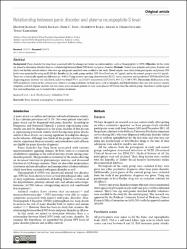Relationship between panic disorder and plasma neuropeptide-S level

Göster/
Erişim
info:eu-repo/semantics/openAccesshttp://creativecommons.org/licenses/by/3.0/us/Tarih
2018Yazar
Baykan, HayriyeBaykan, Özgür
Esen, Emre Cem
Kara, Hayrettin
Hişmioğulları, Adnan Adil
Karlıdere, Tunay
Üst veri
Tüm öğe kaydını gösterÖzet
Background: Panic disorder has long been associated with the changes in various neurotransmitters, such as Neuropeptide-S (NPS). Objective: In this study we aimed to determine whether there is a relationship between blood NPS levels and panic disorder. Methods: Twenty nine patients with panic disorder and thirty two healthy control subjects who were age and gender matched were enrolled to the study. Blood samples were taken from participants and plasma NPS levels were quantified by using an ELISA kit. Results: In the study group, median NPS blood level was 16.7 pg/mL and in the control group it was 32.5 pg/mL. There was a statistically significant difference (p = 0.021). Using receiver operating characteristics (ROC) curve, sensitivity and specificity of NPS blood level, for diagnosing panic disorder was calculated, and it was found 79.3% and 56.25% respectively (AUC:0.672, 95% CI: 0.540-0.787). Discussion: Malfunction at the NPS modulatory system in the cortical areas (which is causing excitations in brain areas, such as amygdala and hypothalamus) does not only increase anxiety symptoms and risk of panic disorder but also causes panic disorder patients to have lower plasma NPS levels than the control group. Therefore it can be argued that such malfunction can be treated with a systemic treatment.
Kaynak
Revista de Psiquiatria ClinicaCilt
45Sayı
4Koleksiyonlar
Aşağıdaki lisans dosyası bu öğe ile ilişkilidir:


















